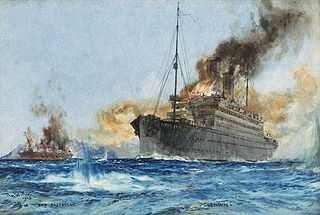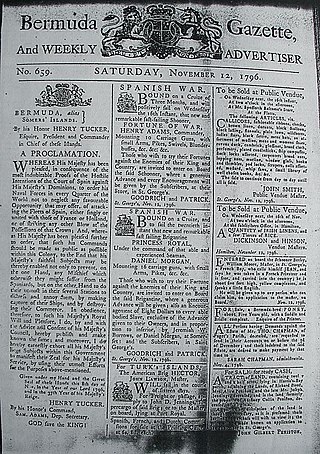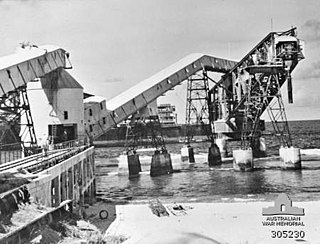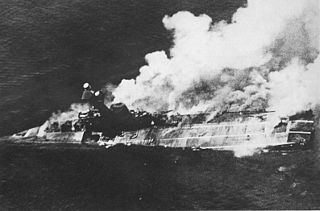
The Kriegsmarine was the navy of Nazi Germany from 1935 to 1945. It superseded the Imperial German Navy of the German Empire (1871–1918) and the inter-war Reichsmarine (1919–1935) of the Weimar Republic. The Kriegsmarine was one of three official branches, along with the Heer and the Luftwaffe, of the Wehrmacht, the German armed forces from 1935 to 1945.

The German auxiliary cruiser Atlantis, known to the Kriegsmarine as Schiff 16 and to the Royal Navy as Raider-C, was a converted German Hilfskreuzer, or merchant or commerce raider of the Kriegsmarine, which, in World War II, travelled more than 161,000 km (100,000 mi) in 602 days, and sank or captured 22 ships with a combined tonnage of 144,384. Atlantis was commanded by Kapitän zur See Bernhard Rogge, who received the Oak Leaves to the Knight's Cross of the Iron Cross. She was sunk on 22 November 1941 by the British cruiser HMS Devonshire.

Merchant raiders are armed commerce raiding ships that disguise themselves as non-combatant merchant vessels.

An armed merchantman is a merchant ship equipped with guns, usually for defensive purposes, either by design or after the fact. In the days of sail, piracy and privateers, many merchantmen would be routinely armed, especially those engaging in long distance and high value trade.

The German auxiliary cruiser Kormoran (HSK-8) was a Kriegsmarine merchant raider of World War II. Originally the merchant vessel Steiermark ("Styria"), the ship was acquired by the navy following the outbreak of war for conversion into a raider. Administered under the designation Schiff 41, 'Ship 41', to the Allied navies she was known as "Raider G". The largest merchant raider operated by Germany during World War II, Kormoran ("cormorant") was responsible for the destruction of 10 merchant vessels and the capture of an 11th during her year-long career in the Atlantic and Indian oceans.

Commerce raiding is a form of naval warfare used to destroy or disrupt logistics of the enemy on the open sea by attacking its merchant shipping, rather than engaging its combatants or enforcing a blockade against them.

Komet (HSK-7) was an auxiliary cruiser of Nazi Germany's Kriegsmarine in the Second World War, intended for service as a commerce raider. Known to the Kriegsmarine as Schiff 45, to the Royal Navy she was named Raider B.

Orion (HSK-1) was an auxiliary cruiser of Nazi Germany's Kriegsmarine which operated as a merchant raider in World War II. Blohm & Voss built her in Hamburg in 1930–31 as the cargo ship Kurmark. The navy requisitioned her at the start of World War II, had her converted into the auxiliary cruiser Orion, and commissioned her on 9 December 1939. Known to the Kriegsmarine as Schiff 36, her Royal Navy designation was Raider A. She was named after the constellation Orion.

The Japanese raiders in the Indian Ocean were those vessels used by the Imperial Japanese Navy (IJN) during the Second World War to pursue its war on Allied commerce in that theatre. Possessing a powerful fleet of warships, prior to the start of World War II, the IJN had strategically planned to fight a war of fleet actions, and as a consequence delegated few resources to raiding merchant vessels. Nevertheless, in 1940, two passenger-cargo vessels – Aikoku Maru and Hōkoku Maru – of the Osaka Shipping Line were requisitioned for conversion to armed merchant cruisers (AMC)s, in anticipation of the likely thrust southward by the Japanese. These vessels were subsequently used as merchant raiders attacking Allied commercial shipping along vital sea lanes of communication between Australia and the Middle East. Using their comprehensive armament and speed to their advantage, the raiders experienced a brief period of success. Japanese raiding in the Indian Ocean largely ceased by the end of 1942 after an action with a Dutch vessel, the Ondina and a Royal Indian Navy corvette, HMIS Bengal in which the Hōkoku Maru was sunk.

The Pinguin was a German auxiliary cruiser (Hilfskreuzer) which served as a commerce raider in World War II. The Pinguin was known to the Kriegsmarine as Schiff 33, and designated HSK 5. The most successful commerce raider of the war, she was known to the British Royal Navy as Raider F. The name Pinguin means penguin in German.

Deutsche Schiff- und Maschinenbau Aktiengesellschaft was a cooperation of eight German shipyards in the period 1926 to 1945. The leading company was the shipyard AG Weser in Bremen.

The Dresden class was a pair of light cruisers built for the Imperial German Navy in the early part of the 20th century. The class comprised SMS Dresden, the lead ship, and SMS Emden. Both ships were laid down in 1906; Dresden was launched in 1907, and Emden followed in 1908. They entered service in 1908 and 1909, respectively. The design for the ships was an incremental improvement over the preceding Königsberg class, being slightly larger and slightly faster, but with the same primary armament of ten 10.5 cm (4.1 in) guns. Dresden and Emden were powered by steam turbines and triple expansion engines, respectively, as part of continued experiments with the new turbine technology.

The SS Mareeba was an Australian freighter built in 1921 and named after the town of Mareeba in Far North Queensland, Australia. She was a 3,472-ton Australasian United Steam Navigation Company vessel.

The German attacks on Nauru refers to the two attacks on Nauru in December 1940. Nauru is an island country in Micronesia, a subregion of Oceania, in the Central Pacific. These attacks were conducted by auxiliary cruisers between 6 and 8 December and on 27 December. The raiders sank five Allied merchant ships and inflicted serious damage on Nauru's economically important phosphate-loading facilities. Despite the significance of the island to the Australian and New Zealand economies, Nauru was not defended and the German force did not suffer any losses.

Prior to World War II, the Indian Ocean was an important maritime trade route between European nations and their colonial territories in East Africa, the Arabian Peninsula, British India, Indochina, the East Indies (Indonesia), and Australia for a long time. Naval presence was dominated by the Royal Navy Eastern Fleet and the Royal Australian Navy as World War II began, with a major portion of the Royal Netherlands Navy operating in the Dutch East Indies and the Red Sea Flotilla of the Italian Regia Marina operating from Massawa.

The Battle of Más a Tierra was a World War I sea battle fought on 14 March 1915, near the Chilean island of Más a Tierra, between a British squadron and a German light cruiser. The battle saw the last remnant of the German East Asia Squadron destroyed, when SMS Dresden was cornered and scuttled in Cumberland Bay.

The action of 8 May 1941 was a single ship action fought during the Second World War by the British heavy cruiser HMS Cornwall and the Kriegsmarine auxiliary cruiser Pinguin/Schiff 33. The engagement took place in the Indian Ocean off the Seychelles archipelago, north of Madagascar. Pinguin caused slight damage to Cornwall, before its fire on Pinguin caused an explosion and sank it.

The German commerce raiders of World War I were surface vessels used by the Imperial German Navy for its Handelskrieg, a campaign against Allied seaborne trade. The ships comprised warships, principally cruisers, stationed in the German colonial empire before the war began, express liners commissioned as auxiliary cruisers and later, freighters outfitted as merchant raiders. These vessels had a number of successes and had a significant effect on Allied naval strategy, particularly in the early months of the war.
MV Alstertor was a refrigerated cargo ship built in 1938 for Anders Jahres Rederi A/S of Sandefjord, Norway by Oresundsvarvet, Landskrona, Sweden as MV Rose. In 1939 a German ship-owning firm, Rob. M. Sloman, bought her to transport fruit between Santos, Brazil and Hamburg. In 1940 the Kriegsmarine requisitioned her and converted her into a support ship for naval operations in the Atlantic.


















